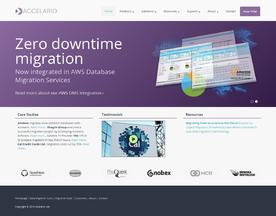Data entry software serves as a cornerstone in modern business environments, where managing vast amounts of information is pivotal for operations and decision-making. These software solutions enable users to input, manage, and manipulate data efficiently, thus streamlining business processes and enhancing overall productivity.
With the right tools, businesses are equipped to handle data with greater accuracy and speed, leading to improved performance.

Integrating data entry platforms with existing business systems is fundamental to creating a cohesive infrastructure. This harmonization allows for seamless data flow and optimized workflows, reducing the likelihood of errors and duplications. Automation features further elevate the utility of data entry software by minimizing manual tasks and facilitating the processing of large datasets with minimal human intervention. As a result, employees can redirect their efforts towards more strategic activities that require human insight.
Cloud-based data entry systems have revolutionized the way data is handled, offering scalability and remote accessibility. These platforms ensure that data is available across different locations, promoting collaboration and enabling a mobile workforce. Advanced analytics and reporting features embedded within data entry software provide valuable insights, assisting businesses to make informed decisions. These tools are key in transforming raw data into actionable intelligence.
Key Takeaways
- Data entry software increases accuracy and efficiency in business operations.
- Integrating automation with data entry processes optimizes productivity.
- Cloud-based platforms enable scalable and collaborative data management environments.
Understanding Data Entry Software
Data entry software streamlines the process of entering information into electronic formats. These tools are essential for ensuring data accuracy and efficiency in various industries.
Core Features of Data Entry Tools
- Automation: Data entry software often includes automation capabilities that reduce manual entry, speeding up the process while decreasing the chance of human error. This feature allows the software to automatically replicate data across systems, helping to maintain consistency.
- Data Validation: Essential to these tools is the ability to validate information as it is entered. This includes checks against pre-defined rules or patterns to ensure the captured data is accurate and useful.
- Data Extraction: Many data entry solutions come equipped with data extraction capabilities. They can identify and extract relevant information from unstructured data sources, such as scanned documents or images, and convert it into a structured format.
- Data Accuracy: A key advantage is the software’s contribution to data accuracy. By incorporating error-detection algorithms and validation checks, these tools minimize inaccuracies in data input.
- Data Collection: They offer efficient data collection methods, enabling users to gather information from different sources and formats, and bring it into a central database for processing.
Types of Data Entry Solutions
- Web-Based Data Entry: These are accessible from any internet-enabled device, facilitating remote data entry tasks and real-time collaboration.
- On-Premises Data Entry: Solutions designed for local installation, providing robust control over data security and requiring physical access to the IT infrastructure.
- Mobile Data Entry: Mobile applications allow for data entry on-the-go, giving field workers the flexibility to capture data directly from their devices.
- Voice Recognition Data Entry: These innovative solutions use voice recognition technology to allow users to enter data verbally, significantly increasing the speed of data capture in certain contexts.
Integrating With Business Systems
Integrating data entry software with existing business systems is paramount to enhancing operational efficiency and data consistency. The effective connection of these systems usually relies on Application Programming Interfaces (APIs) to facilitate communication and data flow.
ERP and CRM Integration
Integrating data entry software with Enterprise Resource Planning (ERP) and Customer Relationship Management (CRM) systems ensures that data flows seamlessly between sales, customer service, and inventory management. Zapier can be employed to automate data transfer between data entry software and popular CRMs, like Salesforce or Dynamics 365, reducing manual entry and errors. ERP systems, such as SAP or Oracle, can be synchronized through their APIs to provide a unified view of business operations.
List of Benefits:
- Synchronized Data: Real-time data updates across platforms.
- Automated Workflows: Minimized manual intervention with automations.
- Enhanced Accuracy: Reduced data discrepancies and duplications.
Accounting Integration
Accounting software, like QuickBooks, can be tightly integrated with data entry applications to streamline financial operations. This integration allows for real-time updating of ledgers and accounts, making financial reporting more accurate and timely. Consistent data transfer minimizes errors that can occur from manual data re-entry across systems.
Important Integrations:
- Invoices and Receipts: Direct entry into accounting ledgers from sales platforms.
- Expense Tracking: Automated expense categorization and tracking.
- Financial Reporting: Simplified and accurate financial statements.
Workflow Management Systems
Workflow management systems benefit significantly from integration with data entry software. Automations can route data to appropriate departments or processes, ensuring that tasks are addressed promptly and efficiently. By integrating with workflow systems, organizations can ensure that data entry tasks trigger subsequent actions without manual intervention, leading to a smoother operation flow.
Key Integration Points:
- Task Management: Automatic task creation based on data entry triggers.
- Process Efficiency: Streamlined processes due to automated data routing.
- Visibility: Increased visibility into the status of workflows.
Enhancing Data Accuracy and Processing
Optimizing data entry software revolves around strategic error reduction and thorough data management processes to improve overall accuracy and efficiency.
Error Reduction Techniques
Effective data entry software incorporates multiple error reduction techniques to ensure high accuracy levels. Techniques such as real-time error alerts and stringent data verification protocols significantly mitigate the risk of inaccuracies. The application of Optical Character Recognition (OCR) and Intelligent Character Recognition (ICR) technologies enhances the ability to accurately convert various types of documents into editable and searchable data.
- Real-Time Error Alerts: Alerts users immediately when an entry does not match predefined formats or when inconsistencies are detected.
- Data Verification: Involves cross-referencing entered data against validated data sources or dual entry systems to confirm accuracy.
| Technique | Description |
|---|---|
| OCR/ICR | Reduces errors in document conversion and data entry by accurately reading characters on the page. |
| Validation Rules | Customizable guidelines that prevent incorrect data entry by flagging discrepancies as they occur. |
Data Cleaning and Classification
Data cleaning and classification are essential aspects of data management that significantly enhance the value of the captured information.
- Data Cleaning: This step involves scrutinizing entered data for errors, redundancies, and inconsistencies and correcting them to ensure that only high-quality data remains. It employs algorithms to identify and rectify anomalies.
- Data Classification: Sorting and categorizing data into predefined groups makes it easier to access, manage, and analyze.
| Process | Purpose |
|---|---|
| Data Cleaning | Refines the dataset by detecting and correcting inaccuracies, leading to reliable analysis. |
| Data Classification | Organizes data into logical categories for better accessibility and utility. |
By implementing these advanced techniques, businesses can significantly reduce errors and enhance the processing capabilities of their data entry software.
Automation in Data Entry

Automation in data entry transforms the efficiency and accuracy with which data is processed. Integrated technologies like Robotic Process Automation (RPA) and artificial intelligence (AI) streamline the capture and management of data.
Robotic Process Automation
Robotic Process Automation (RPA) refers to software robots or ‘bots’ that mimic human actions to perform repetitive and rule-based tasks. RPA bots are proficient in tasks such as entering data, copying and pasting, and moving files. This automation reduces the likelihood of human error and increases speed. An example of RPA’s application could be the automated migration of invoice data from emails directly into accounting software.
AI-Powered Data Capture
On the other hand, AI-powered data capture solutions utilize machine learning and natural language processing to understand and digitize information from various document types and formats. Unlike RPA, AI can recognize and adapt to different data structures, improving over time through continued learning. This capture ability is particularly useful for classifying documents, extracting critical information, and entering it into appropriate databases or systems.
- Advantages:
- AI can process unstructured data.
- Machine learning models become more accurate the more they are used.
By employing these technologies, businesses can significantly reduce the time and resources spent on data entry tasks.
Optimizing Data Workflows

Effective optimization of data workflows often involves automating recurring tasks and employing customizable forms and templates. These enhancements streamline processes and reduce manual inputs, leading to increased efficiency and accuracy in data management.
Automating Recurring Tasks
Workflow automation stands as a cornerstone of an efficient data entry solution. By automating routine data tasks, organizations can significantly reduce the time and effort involved in data management. For example:
- Batch Processing: Enables the handling of large volumes of data simultaneously, reducing time spent on repetitive tasks.
- Data Validation: Automates the verification of data against predefined rules, ensuring accuracy and consistency.
Implementing automation can yield measurable improvements in the workflow’s throughput and error reduction.
Customizable Forms and Templates
Customizable forms and templates offer flexibility and control over data entry, which is essential for adapting to varied data requirements. Key advantages include:
- Template Variety: Provides a range of templates suited to different types of data collection, ensuring relevance and efficiency.
- Flexibility in Design: Users can tailor forms to match specific information needs, enhancing the data entry solution’s applicability to diverse scenarios.
Utilizing customizable forms streamlines the data entry process, making it more intuitive and adaptable to unique organizational needs.
Leveraging Cloud-Based Platforms

In the era of digital transformation, cloud-based platforms have become pivotal for data entry software, offering enhanced security and seamless collaboration capabilities.
Advantages of Cloud Solutions
Cloud-based solutions offer several tangible benefits for businesses and their data entry processes. First and foremost, scalability is a key advantage. Companies can adjust their resource usage based on current needs without the overhead of physical infrastructure. Additionally, cost savings are evident as cloud-based platforms operate on a subscription model (SaaS), eliminating the need for significant upfront hardware investments and maintenance costs.
- Accessibility: Users can access cloud platforms from anywhere, which increases productivity and flexibility.
- Backup and Recovery: Cloud solutions provide robust backup and disaster recovery options, ensuring data integrity.
Security and Collaboration on the Cloud
When it comes to security, cloud providers implement stringent measures to protect data. Encryption protocols and multi-factor authentication are commonly employed to safeguard sensitive information. For collaboration, cloud-based data entry software excels, allowing multiple users to work on the same dataset in real-time, regardless of their location.
- Data Protection: Providers follow strict regulations to ensure data privacy and protection.
- Real-Time Collaboration: Teams can update and share data instantaneously with a cloud-based solution.
Cloud platforms revolutionize how businesses handle data entry by providing secure, collaborative, and cost-effective tools that adapt to their ever-changing needs.
Analytics and Reporting Features

Data entry software often provides robust analytics and reporting features, enabling users to transform raw data into actionable insights. These tools furnish businesses with the means to track performance, identify trends, and make informed decisions.
Dashboard Insights
Dashboards in data entry software serve as centralized platforms that display key data points and metrics. They offer:
- Real-time visualization: Users can monitor data as it is being entered and processed.
- Customizable interfaces: Businesses can tailor dashboards to show the metrics that matter most to them.
- Interactivity: The ability to drill down into specifics from general overviews enhances the user experience.
These dashboards synthesize data from various sources to provide a comprehensive view of business operations.
Data-Driven Decision Making
The analytics capabilities of data entry software empower organizations with:
- Trend analysis: Through historical data comparison, users can forecast future patterns and performance.
- Report generation: Automated report capabilities allow for the seamless compilation of data, saving time and reducing human error.
- KPI tracking: Key Performance Indicators (KPIs) help measure success against objectives.
This functionality helps leaders to rely on quantified data, rather than intuition, steering their strategy with confidence.
Choosing the Right Data Entry Software

When selecting data entry software, one must carefully evaluate vendors and explore trial periods or demos to ensure the tool meets their specific needs.
Assessing Software Vendors
Companies should start by examining the credibility and reliability of software vendors. The track record of a vendor can be gauged through customer feedback, case studies, and industry rankings on platforms like Capterra. It’s essential to check the customer service and support options a company provides. Businesses should also consider:
- The vendor’s experience in their industry
- Software scalability and integration capabilities
- Security measures and compliance certifications
- User reviews and ratings, specifically looking at the negatives to identify any trends of concern
Trial Periods and Demos
A hands-on approach is vital for assessing if the software aligns with one’s workflow. Companies should take advantage of Free Trial offers whenever available. Zoho Forms and other data entry software options often provide this to allow potential users to interact with the features firsthand. During trial periods or while viewing demos, one should:
- Test ease of use: Can the team adapt quickly? Is the user interface intuitive?
- Evaluate feature set: Are all necessary data entry functions present?
Use the following checklist to guide trial evaluations:
| Feature | Importance | Present in Trial |
|---|---|---|
| Custom form fields | High | Yes/No |
| Data import/export capabilities | High | Yes/No |
| Automation features | Medium | Yes/No |
| Real-time collaboration | Low | Yes/No |
| Mobile support | Medium | Yes/No |
Engaging with a trial or demo aids in making an informed decision, ensuring the software selected is well-tailored to meet the specific data entry needs of the business.
Frequently Asked Questions

This section addresses common inquiries regarding data entry software, ranging from learning resources to program features essential for efficient data processing.
What are some popular software applications used for data entry?
Popular software applications for data entry include Microsoft Excel, Google Sheets, and Zoho Forms. These tools are widely utilized for their user-friendly interfaces and robust feature sets.
How can someone learn data entry on their own?
Individuals can learn data entry through online tutorials, courses on platforms such as Udemy or Coursera, and by practicing with free versions of data entry software. Consistent practice is key to becoming proficient.
Which data entry tools are available for free?
Tools such as Google Forms and OpenOffice Calc are available for free and offer a range of data entry capabilities. These programs are accessible to anyone with an internet connection or basic computer access.
Are there any data entry programs that integrate well with Excel?
Data entry programs like Microsoft Forms and Access can be seamlessly integrated with Excel. These integrations allow for efficient data transfer and manipulation within the Microsoft Office ecosystem.
What skills are essential for efficient use of data entry software?
Key skills for data entry software include a strong attention to detail, fast typing speed, basic understanding of databases, and familiarity with spreadsheet functions. Mastery of these skills contributes to accurate and efficient data processing.
What features should be considered when choosing the best data entry software?
When selecting data entry software, features to consider include data validation rules, automation capabilities, ease of collaboration, and reporting functions. It is also important to evaluate the software’s compatibility with existing workflows.
Compare hundreds of Data Management Software in our Software Marketplace














